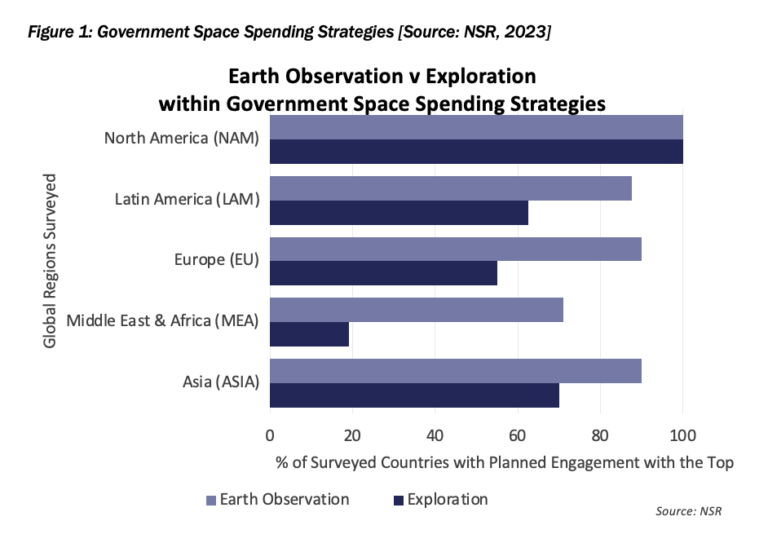Government Space Spending Priorities - Earth vs Exploration
Engaging with space is increasingly attractive for governments. It is a sector with huge potential benefits to nation states, however for new players and emerging space nations involvement is a risk. With the relatively high costs of developing industry, early ‘returns’ are key for on-going stakeholder engagement. Evaluating the potential for long-term investment, interested nation states plan towards the speediest route for maximum impact with minimum risk. So, with so many potential avenues of access to the industry for emerging nations, where do emerging space nations focus, exploration or Earth?
NSR’s Government Spending on Space (GSoS) sees Earth Observation as one of the highest priority interest items for new space players. Governments are interested in exploration across all regions however exploration tends to be a focus for more established space nations.
Why is Earth Observation so universally attractive?
With an increasing number of natural disasters impacting nation states globally, concerns of climate impact attracting public engagement, and the interest in early warning protections against futures hazards, Earth Observation has had increasing opportunity to demonstrate use potential as seen by its use to assess damage during the 2023 Turkish Earthquake. This is clearly attractive to governments looking to address specific nation state challenges such as landslide risk and population growth, which was recently studied via Earth Observation satellites in the Democratic Republic of Congo. This provides the added benefit of practically demonstrating to citizens what their governments are doing to help the average person.
Earth Observation is also one of the easier access points for interested nations wishing to attract or use space organisations. With CAPEX and time commitments likely significantly lower than infrastructure or communications-based projects, nation states can look to Earth Observation for cheaper results from investment. Recent assessments of the benefits of enhanced air pollution tracking (to include satellite data) suggest that savings to health services from decreases in associated mortality and illnesses to be in the billions (US dollars).
Exploration missions are attractive in a different way, appealing to imagination, inspiration, and national prestige however when proving the worth of your governmental spend, a lack of tangible impacts/ benefits internally may see public excitement short lived.
Considerations for Potential Earth Observation Players
Specific Needs of Specific Nations
Events such as natural disasters, Brexit, the COVID Pandemic and Ukrainian war have all played a part in shaping Earth Observation strategy across the global. With such diverse areas of concern, providers must look towards the specific needs of potential customers. Nations are interested but action is not a given. Countries such as Pakistan, working to rebound from the 2022 floods need access to data that aids with this goal such as via the eDrift Copernicus efforts which were used in post-disaster needs assessment. Non-specific data is not going to appear on national purchase wish lists where buying power is limited.
Disaster Management: Adaptability and Rapid Response
The rapidly shifting global dynamics of the 2020's has demonstrated the need for adaptability in governmental approaches. When the need for data occurs during a disaster, the need is immediate. Service providers will benefit from being prepared to offer the ability to rapidly address new challenges as needed by nation states e.g. Greece shifting from monitoring land use activity risks to focusing on forest fire development and its human impact. Service providers who are ready will benefit in the long-term from establishing relationships based on proven ability.
Considerations for Potential Exploration Based Players
Overall exploration activity continues however with current levels of global socio-economic instability previously declared missions of interest may now face challenges to capture full funding goals with many potential missions vying for cash. When financial instability hits, space-based activity is viewed as an easy drop by many. NASA is already facing a FY24 budget not only less than requested, but less than FY 2023. Active players in this industry must be prepared for increasing risk with the increasing opportunity.
Long-term, motivation to participate in programs like Artemis should increase (28 countries having already signed the Artemis Accords). However, expect these types of opportunities to largely sit firmly with more established space nations. Although ‘early stage’ space countries are setting their sights away from earth, their budgets are focused closer to home.
The Bottom Line
Earth Observation is the ‘safe play’ for Government Spending on space resources. For emerging space nations, stakeholders likely prefer spending on programs with ‘clear terrestrial benefits’ while established space nations are happy to look further afield. Players should target revenue capture accordingly.
Author

Sarah Halpin
Analyst, space and satellite, expert in government and military spaceRelated items
Article
Predictions for the space industry in 2025
Forecast report
MSS and D2D satellite services for government and military organisations: trends and forecasts 2023–2033
Article
AI in space players that serve the government and military sector should focus on greenfield opportunities
